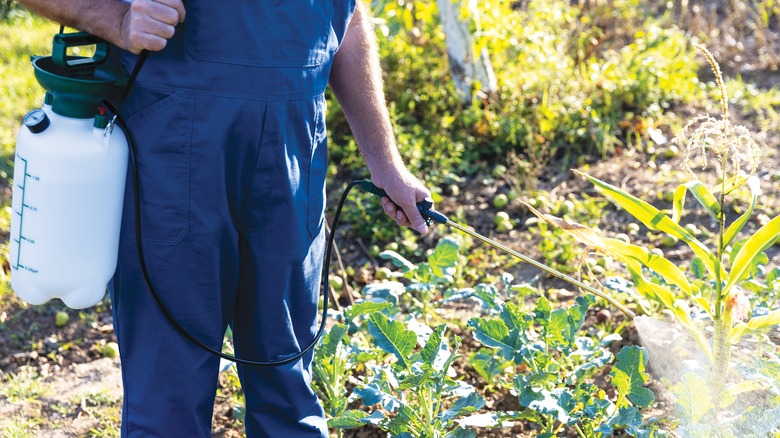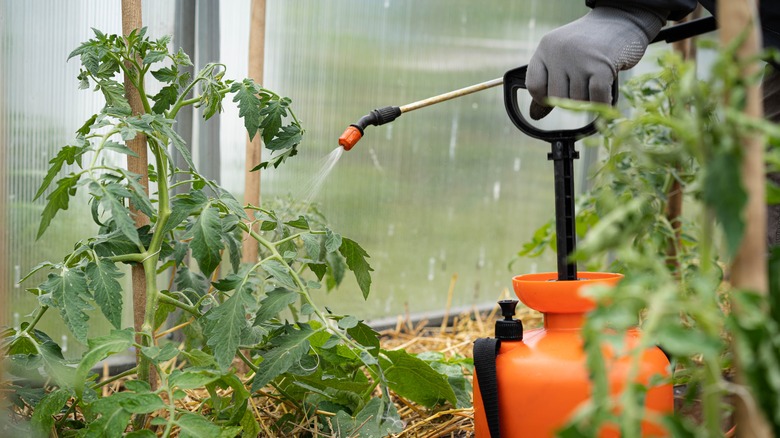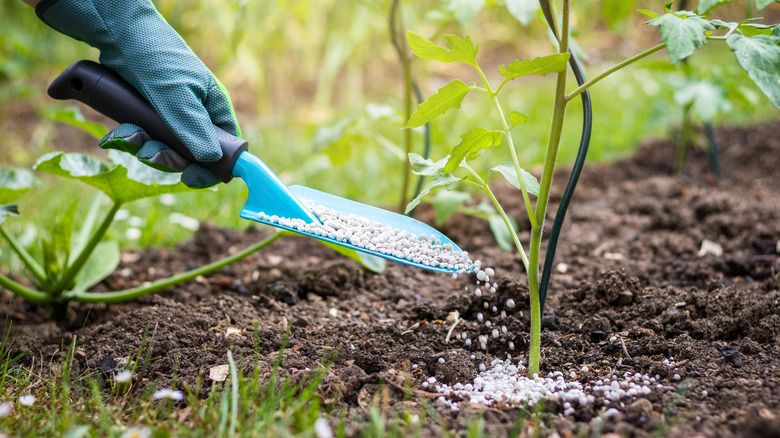How To Properly Apply Urea Fertilizer With A Hose Sprayer
If one fertilizer could be metaphorically dubbed as the popular kid in school, it would be urea. The crystalized soil supplement accounts for over 50% of nitrogen fertilizer applications in the world. For the average home gardener, you've likely used urea to boost the health of your lawn or vegetable garden, especially if your soil is lacking in nitrogen. But fertilizer application can be time-consuming. As a busy gardener, every second counts. This is where you might consider using a hose sprayer to save time in the fertilizer application process. When it comes to urea, however, there is a proper way to apply the nutrient with said hose sprayer so your plants get the most benefit from it while minimizing potential risks.
Although you may be eager to administer urea to your plants, there is some preparation required before doing so. The fertilizer crystals need to be dissolved before they can be applied as a foliar spray with the hose sprayer. Similarly, the one you use should be appropriate for your needs. The spray nozzle should be adjustable to achieve the proper chemical-to-water ratio and pressure setting, so using an Ortho Dial N Spray hose end sprayer (or something similar) is helpful. Lastly, understanding what plants can be fertilized with urea is essential, as well as knowing what alternative application methods to consider.
Prepping and applying urea as a foliar spray
Since urea can aggravate your eyes, skin, and lungs, safety goggles and protective clothing should be worn when handling the product. To make a foliar spray with the high-nitrogen substance, dissolve 1 pound of urea in 1 gallon of water in a bucket. Warm water is preferred because although urea is highly soluble, it can be slow to dissolve in cool water. Don't use
When your urea is dissolved, connect your spray nozzle to a hose, fill the reservoir on your hose end sprayer with the urea solution, and fit the container to the bottle attachment on the nozzle if applicable. This allows your urea solution to mix with water as it's discharged from the hose for a faster application. Plus, further diluting the urea with water avoids burning your plants.
If you have a urea liquid fertilizer concentrate, you can simply add it to your hose end sprayer's reservoir and calibrate the mixing dial to match the recommended amount on the label for 1 gallon of water. Use the shower setting on the nozzle to apply the product to vegetables and plants. Point the hose towards your plants and hold the trigger to release the liquid and spray the undersides of your leaves — but only do so when temperatures are below 80 degrees Fahrenheit and there is no wind. Don't use any kind of urea that has more than 0.5% biuret as a foliar spray.
What plants to apply urea to and alternative application methods
The good news is that many plants in your home and garden can benefit from an application of urea. This includes a variety of vegetables like leafy greens, cruciferous vegetables, berries, and nightshades. The substance can also be useful for flowering plants and houseplants. How much fertilizer you really need in your garden will differ depending on the veggie, so it's important to understand their urea requirements during the growing season. Likewise, the application rates of urea when used for flowering and indoor plants depends on various factors, so it's best to follow instructions on the fertilizer label when possible.
And you don't only have to apply urea as a foliar spray. The fertilizer can be applied using other methods like soil application. With this process, urea can be broadcast with a spreader or injected or banded into the ground. Alternatively, the crystals can be placed on the soil as a top dressing and watered into it with a hose or from rainfall. You can also add nitrogen to your soil in other ways, but with the plethora of application methods and plants that benefit from the fertilizer, urea is a garden supplement that is tough to beat.


